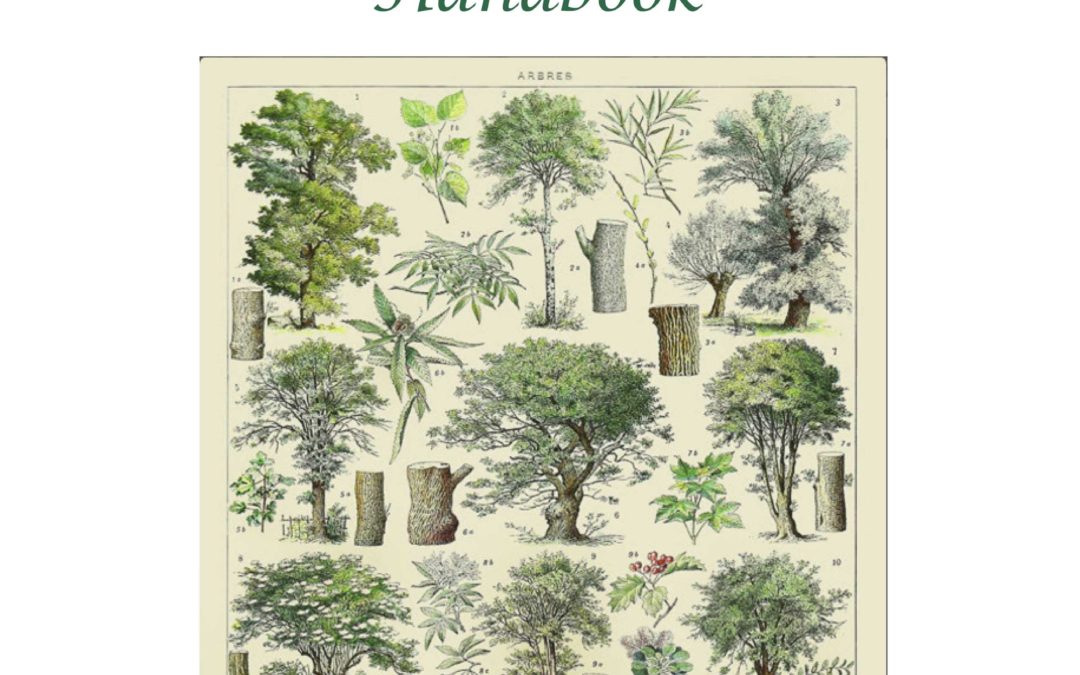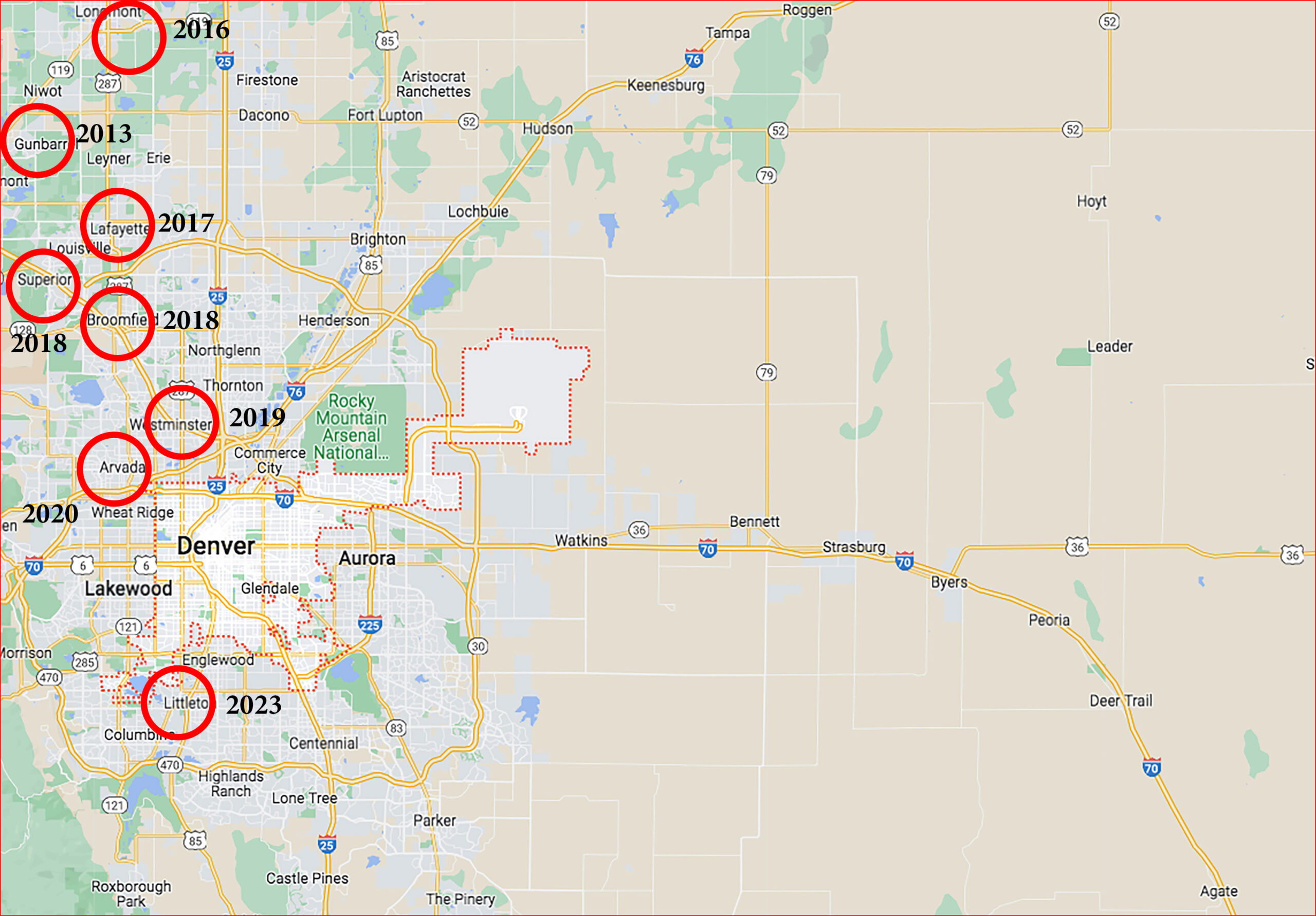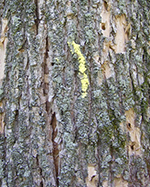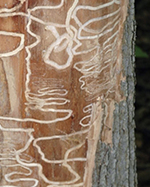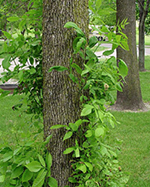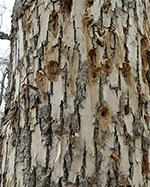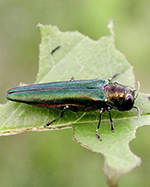The Emerald Ash Borer Is Here to Stay
To help our customers, Ross Tree, a locally owned and operated Denver tree company, created an Emerald Ash Borer Handbook to inform home and business owners about this troublesome iridescent green beetle. The Emerald Ash Borer (EAB) is a big deal because this insect has killed hundreds of millions of Ash trees east of the Mississippi. Unfortunately, the beetle arrived in Colorado in 2013 and has spread to Boulder, Gunbarrel, Longmont, Lafayette, Lyons, Superior, Broomfield, Westminster, Arvada, and Fort Collins. It is slowly spreading along the Front Range. In the summer of 2023, it arrived in Littleton, 14 miles south of Aravda. We do not know if the insect flew over the western edge of Denver, Lakewood, and Englewood to land in Littleton or came in a truck of infected firewood. The EAB is moving, and it is time to protect and manage all Ash in the Denver Metro Area.
The insect attacks Green, White, Black, and Blue Ash, which have zero immunity. With 1.45 million Ash in the Metro Denver area, the death of that many trees would be catastrophic to the city’s urban forest and reduce home property values. Once found in a city, it stays, but treatment each year keeps trees safe from the insect. The Emerald Ash Borer Handbook shows homeowners how to identify ash trees and their EAB treatment options.
Is the EAB in Denver?
The EAB spread rapidly across states east of the Mississippi River, killing millions of Ash. In contrast, the beetle seems to be moving slowly along the Front Range and has not been confirmed yet within the Denver city limits. One reason the EAB moves slower in Colorado is that Ash is not native to the state. We do not have large tracts of hardwood forests with Ash to help transport the pest to other sections of the state. Secondly, Front Range city foresters have not idly waited for the EAB to land in their jurisdictions. They implemented Ash management programs starting in 2013 to treat healthy mature trees with long-lasting systemic products and remove any marginal trees. Denver’s “Be A Smart Ash” and similar programs across the Front Range reduced the number of Ash the EAB can attack. But be warned, once the EAB arrives in Denver, it will be next to impossible to get a treatment appointment, so it is best to be proactive now and get high-value trees treated.
Denver-based tree service companies have an obligation to inform the local forest service if they think they have found Emerald Ash Borers at a job site. They should get their ISA-certified arborist to identify the species. If their arborist suspects it is EAB they need to ask the local forester to join them at the job site. Ross Trees’ general manager discusses the verification process above.
What is the Emerald Ash Borer?
Colorado is home to 92 flathead borers that feed on various fruit, Ash, Willow, Birch, Cottonwood, and Locust trees. By far the most destructive, the EAB is an invasive species that entered the country in wooden packing materials from China in 2002. It is the beetle’s grubs that do the majority of the damage. After hatching, their larvae tunnel into the interior of a tree and mine the transport tissues for one or two years, restricting the plant’s movement of nutrients. As the adults emerge, they chew a distinctive D-shaped exit hole to find a mate and start the cycle again.
Resistance Is Not Futile
In 2013, many city foresters along the Front Range traveled or called their counterparts east of the Mississippi to get advice. Told not to wait, each city came up with a plan to identify all the Ash along public-right-of-ways, around public buildings, and inside parks. The identification process helps the foresters decide which trees to treat or actively remove. Small ash trees, those with trunks less than 12 inches in diameter, should be replaced with other species. As the newly planted trees grow, they add canopy as the inevitable Ash dieback occurs, lessening the impact to each city’s urban forest.
Next, each city initiated a public relations campaign to educate its citizens on the benefits of saving Ash trees, tree identification, and all treatment options. Denver’s highly successful Be A Smart Ash is ubiquitous across the city. Denverites’ awareness about the EAB is high, with many homeowners actively treating their Ash. For more information about Denver’s effort, please check out the Be a Smart Ash website.
“Once you find it, it’s already been in your forest for two to three years.”
City of Denver Forester
Prevention is the Best Approach
The insect will eventually arrive in Denver by flying here or inside a load of infested firewood, nursery stock, or lumber products. The tree borer is hard to detect because most of the harm is underneath the bark unseen, so prevention is the best approach to save mature Ash trees. City foresters do expect homeowners to protect and manage all the Ash in their yards. Below are steps to manage Ash located on residential properties.
- Action 1 – Ash Tree Identification
In the Denver area, there is a 15 percent chance that an Ash is growing on a property. The first step for homeowners is to determine if there are any Ash trees in their yard. Check out the video above from the Colorado State Forest Service to see how to identify Ash trees.
Ash trees have the following characteristics:
• Compound leaves with 5 to 9 leaflets
• Leaflets, buds, and branches growing directly opposite from one another
• Diamond-shaped bark ridges on mature trees - Action 2 – Are Your Ash Trees Worth Saving?
As a rule of thumb, a mature tree landscape is worth about ten percent of the value of a home. Since Denver is a hot real estate market, this means an Ash with a 15-inch Diameter at Breast Height (DBH) is worth the cost of a new car, so worth saving. To get a tree’s DBH, measure the circumference of the tree 4.5 feet from the ground, and divide it by Pi or 3.14. Any trees higher than 15 DBH need to be treated by a professional tree service company with an applicator’s license from Colorado’s Agriculture Department. Any Ash trees under power lines or in poor health are not worth saving and need tree removal. Typical signs of poor health are dieback, woodpecker damage, bark splits, and trunk spouting.
- Action 3 – Professional Treatment of Mature Ash Trees
Homeowners should hire a professional tree company for three reasons – trees are valuable, the work is hazardous, and tree health issues are complex. Since EAB damage goes unseen, it takes an expert to determine its presence. Also, the beetles’ breeding cycles are temperature-dependent, which makes treatment timing difficult.
Trunk injections are a good choice when the site conditions prevent the use of sprayed or soil-applied products. Trunk injections require the knowledge to determine the correct dosage, and some products require the applicator to be licensed. Since tree injections provide reliable insect control for at least two years, this makes them cost-effective.
The best time for EAB treatment is between April and October when Ash trees are leafed out. The trees must be actively transpiring to take up the control formulations and spread them throughout the tree for protection. To understand the benefits of systemic injections, please click on our blog titled, “Ask a Professional – Why Use Systemic Products to Control Tree Pests?”
Does Your Ash Tree Have EAB?
After their eggs hatch, the EAB larvae bore into the tree and feed on the Phloem, Cambium, and Xylem layers for two or three years, eventually girdling the tree. By the time a property owner notices pretty jewel green beetle adults flying around, their tree cannot be saved. So prevention is the best tactic to control the EAB. Use the pictures below in the Emerald Ash Borer Handbook to see signs of EAB presence.
- Die Back – Infected trees have sparse leaves or branches in the upper part of the tree.
- Splits in Tree Trunk – The trunk has vertical splits in the bark.
- Tunneling Underneath the Bark – The larvae mine winding S-shaped tunnels inside the tree, sometimes visible through vertical bark splits.
- D-shaped Exit Holes – Adult flathead beetles form exit holes about 1/8 inch wide.
- Trunk Sprouting – New sprouts grow at the base of a tree, signifying a stressed or dying tree.
- Woodpecker Activity – Woodpeckers strip off bark or peck holes to look for EAB larvae to eat.
- Adult EAB Presence – After the grubs pupate, the adult beetles emerge, start feeding on Ash leaves, and fly around.
Healthy Trees Fight Ward Off Tree Pests
Denver’s weather is tough on trees, and our soil and climate are great for growing grass. Since the vast majority of trees growing in the Denver Metro Area are not native, it makes sense that trees here need extra attention to keep them healthy. Well-watered and fertilized trees can ward off tree pests, including the EAB.
As Denver’s Forester stated above, the EAB is here to stay, and it is just a matter of time when this pest arrives in Denver. Homeowners with Ash trees in their yards need to sit down with a tree company and plan how to manage their trees. Once the EAB hits Denver, it will be next to impossible to make an EAB treatment appointment because the tree service industry will be overwhelmed. So homeowners need to be proactive to save their landscape Ash in 2021.
Keep this handy Emerald Ash Borer Handbook around. It shows homeowners how to identify ash trees and their EAB treatment options. The Ross Tree Plant Health Care Department offers tree watering, fertilization, and systemic injections to keep Ash trees healthy and resistant to the EAB. Click here to request tree service or call 303-871-9121 for an appointment. We are at your service.

